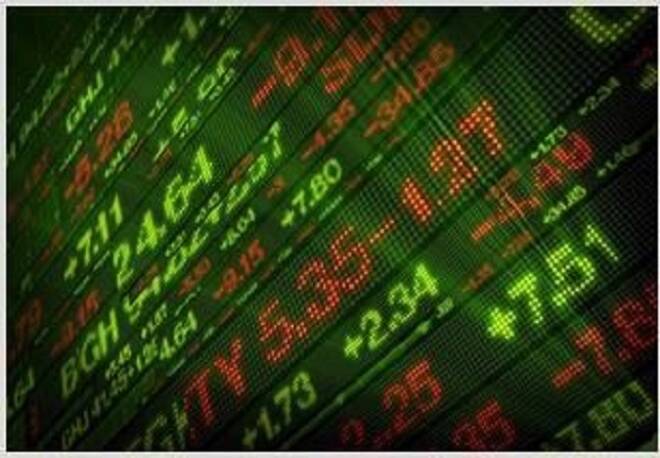Advertisement
Advertisement
Annual Global Indices Outlook – 2016
By:
The major global stock indexes were relatively strong in 2016 with most of the year’s gains coming in the last two months of the year. In the U.S., for
The major global stock indexes were relatively strong in 2016 with most of the year’s gains coming in the last two months of the year. In the U.S., for example, a post-election rally drove all the major indexes to record highs. The smaller-cap, Russell 2000 Index, which is typically the most volatile, performed the best. As of December 23, this index was up 20.10% for the year.
The technology-heavy Nasdaq Composite Index lagged the other major indexes, posting an 8.20% gain as of December 23. The catalyst behind the relative weakness was a surge in long-term interest rates which may have fueled concerns with investors over whether a lower value should be placed on the future earnings of the many fast-growing and highly valued stocks included in the benchmark index.
The blue chip Dow Jones Industrial Average posted a robust 13.57% gain while the benchmark S&P 500 Index was up 9.84%. Each performed well because of their exposure to financial market shares and the industrial sector.
Higher interest rates and improved lending margins, along with expectations of less regulation under Trump’s administration, helped underpin financial sector stocks. Industrial sector stocks were also particularly strong, bolstered by expectations for higher defense and infrastructure spending.
Helping to put a lid on the Dow and S&P 500 near the end of the year were weak utilities and telecommunication shares. Rising U.S. Treasury yields made their high dividend yields less appealing to investors.
As far as the S&P 500 sectors were concerned, energy was the best performing with an expected gain of 26.75% in 2016. This is followed by Financial with a return of 21.94%, Industrials up 18.83%, Materials up 15.78 and Technology with a 14.34% increase.
Rounding out the top ten sectors, Utilities were up 12.32%, followed by Consumer Discretionary stocks which were up 5.49% and Consumer Staples which came in up 3.11%.
The weakest year-to-date sectors were Healthcare, losing 3.57% and Real Estate which is in a position to lose about 2.74%.
Major Global Equity Indexes
It is often said that a rising tide lifts all ships and that proved to be true in the major global equity indexes in 2016. The differences in their performances can be attributed to the weighting of various sectors and their exposure to return and risk.
In the U.K., the FSTE 100 Index rose 13.01%. This was followed by Australia’s S&P/ASX Index with an 8.07% gain. Germany’s Dax Index last traded on December 23 up 6.73%, followed closely by the grossly underperforming Japanese Nikkei 225 Index which is up 2.70% for the year just a week before the new year.
Events
During the first month of 2016, global equity markets plunged as concerns over China’s economy led to extreme weakness and market volatility. Throughout the Spring, there remained worries about the perils of the global economy.
Global equity markets were hit hard initially after the U.K. voted to leave the European Union in late June, however, the markets were able to recover throughout the summer.
The markets traded sideways from early July to early November as investors awaited the outcome of the U.S. presidential elections and news from the Fed regarding the timing of the next interest rate hike by the Fed.
Although it was heavily predicted that a Donald Trump win in the election would crash the stock markets, his victory actually triggered a huge rally that drove the major U.S. Indexes to new all-time highs. At the end of year, the Dow stood within striking distance of the 20,000 mark.
Forecast
Three things to consider at the start of 2017. Firstly, it’s too early to assess the election’s impact on the economy and stock markets. Secondly, I think that Trump’s win boosts hope for fiscal stimulus and deregulation and these are positives for certain sectors of the economy. Thirdly, the strength of the market will be determined by its ability to withstand the Fed’s expected rate increases.
Essentially, there will be a bullish tone at the start of the year because of optimism over Trump’s proposals. Fiscal stimulus and deregulation are not bad words, provided the money is spent right and the new rules don’t lead to problems in the futures. Finally, the stock market has operated for a long time without the threat of a rate hike. The frequency of the Fed’s hikes in 2017 will give investors another issue to worry about so this could develop into a problem if investors aren’t prepared for the impact of higher rates.
Related Articles
About the Author
James Hyerczykauthor
James is a Florida-based technical analyst, market researcher, educator and trader with 35+ years of experience. He is an expert in the area of patterns, price and time analysis as it applies to futures, Forex, and stocks.
Did you find this article useful?
Latest news and analysis
Advertisement
